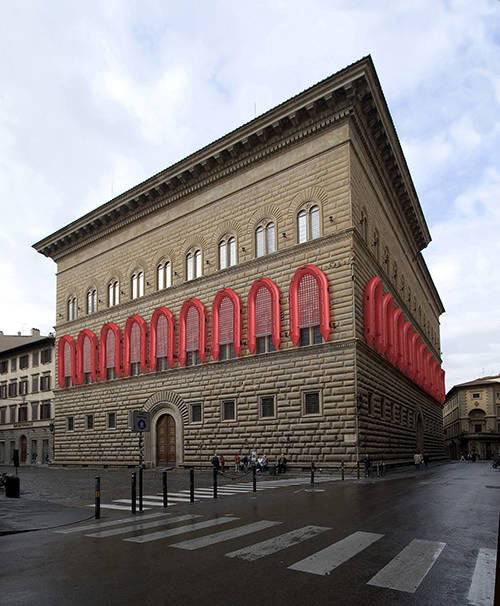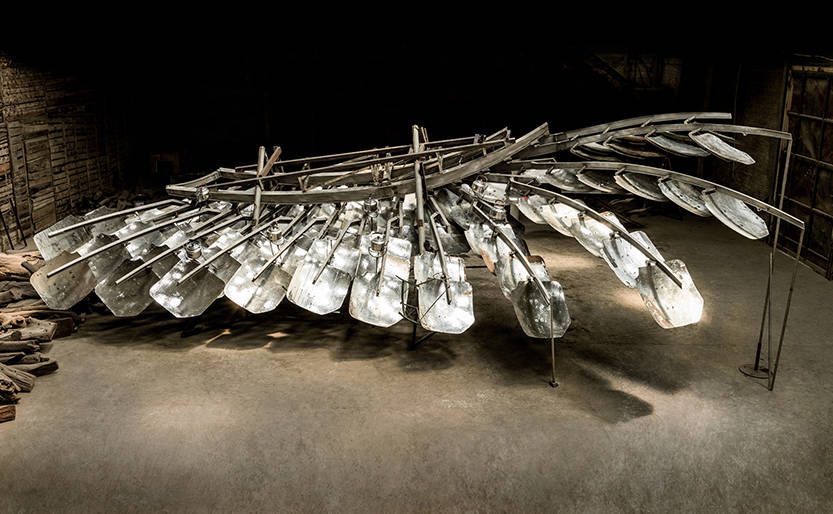location: Palazzo Strozzi, Firenze
year: 2016
"I never separate my art from my other activities . There is a political impact in my work and I do not stop being an artist when I deal with human rights. Everything is art, everything is politics " Ai Weiwei
From September 23rd, 2016 to January 22nd, 2017, Palazzo Strozzi in Florence hosts the first great italian retrospective dedicated to one of the most celebrated and controversial contemporary artists, Ai Weiwei: an exhibition curated by Arturo Galansino, director of Fondazione Palazzo Strozzi.
Dissident artist and icon of the struggle for freedom of expression, Ai Weiwei is globally known for the union of political activism and artistic practices through a spectacular and provocative works. Protagonist of exhibitions at major museums in the world, Ai Weiwei invades with its extraordinary creative freedom all Palazzo Strozzi spaces: the facade, the courtyard, the Piano Nobile and Strozzina with iconic monumental installations, sculptures and symbol of its objects career, video and photographic series by the strong impact. For the first time Palazzo Strozzi is used as a unified exhibition space, creating a totally unprecedented for its visitors and allowing the artist to confront the Chinese with a rich context of historical and architectural cues stresses. A great new artist installation, involves two Renaissance facades of the building with twenty-two large orange life rafts anchored at Palazzo Strozzi windows: a project that brings attention to the fate of refugees who daily risk their lives to reach Europe crossing the Mediterranean.

The center of the courtyard is dominated by “Refraction”, a giant metallic wing made of solar panels immobilised by its great size and its weight of more than five tons, a suggestive metaphor of constriction and the denial of freedom. Within the spaces of the Piano Nobile and Strozzina, the exhibition offers a journey through past creations and new works, allowing a total immersion in the artistic world and personal biography of Ai Weiwei. The works on display range from the New York period of the eighties and nineties, where he discovered the art of his "masters" Andy Warhol and Marcel Duchamp, the great symbolic works of the new millennium made of assemblies of materials and objects such as bicycles and stools, up until the political and controversial works that have marked the most recent periods of his production, like the portraits of political dissidents in LEGO or recent projects on migration in the Mediterranean Sea. Symbols of the fight for freedom of expression in his works blend references from Chinese history, past and present. A carrer most notable for the opening of the new Olympic stadium in Beijing in 2008, which he created along with Herzog & de Meuron. In the same year he started a series of actions and works of art that criticised government censorship of the earthquake in Sichuan, including publishing on his blog the names of nearly six thousand children which died under the rubble of schools and hospitals. Consequently, the blog recieved 17 million visits and 100,000 hits each day, but was taken offline in 2009, while in 2011 Ai Weiwei was arrested and imprisoned for 81 days. For the next four years, his passport was confiscated and his personal freedom, preventing him to travel and talk to the press have since been limited. However, this has not limited his artistic production and the growth of his global reputation. The artist continued to exhibit his works in major museums and international spaces becoming one of the most followed personalities in the world on social networks, used as a tool for dissemination of his art and his political critiques.

Ai Weiwei and Palazzo Strozzi: to not forget the victims of the earthquakes.
Ai Weiwei and Palazzo Strozzi: to not forget the victims of the earthquakes. At 14.28 on 12th May 2008 in Sichuan, an earthquake measuring 8.0 on the Richter scale claimed approximately seventy thousand victims. Thousands of students died in the collapse of schools, schools which collapsed because of low quality materials used. Ai Weiwei went to the spot and started an investigation that led him to criticise the Chinese government for not taking responsibility for this tragedy and their attempts to cover-up. The memory of the drama, because it recalls the recent tragedy suffered by the people of central Italy during the earthquake of August 24th, 2016, is crystallised in a series of works such as “Snake Bag”, made up of 360 school bags sewn to form a snake, reminiscent of the many items that belonged to the young victims found by the artist in the rubble. “Rebar and Case” consists of fine huali wood containers with white marble reproductions of twisted iron rods found in the rubble. The containers evoke the coffins and the distorted form reflects the objects that remain. The coincidence of the exhibition at Palazzo Strozzi with what happened in Amatrice, Accumoli, Arquata Del Tronto and Pescara makes the presence of this installation even more significant and emblematic. To support victims of the earthquake that devastated Central Italy, the Palazzo Strozzi Foundation, on September 25th , the first Sunday of the 'Ai Weiwei. Libero' exhibition, will donate the proceeds of the day to the population affected in the quake. The exhibition is promoted and organised by the Fondazione Palazzo Strozzi with the support of Comune di Firenze, Camera di Commercio di Firenze, Associazione Partners Palazzo Strozzi and Regione Toscana, and is made possible by the support of Banca CR Firenze / Intesa Sanpaolo and cooperation with Galleria Continua, San Gimignano / Beijing / Le Moulins / Habana.
title: AI WEIWEI LIBERO
location: Palazzo Strozzi
dates: September 23rd, 2016 - January 2017
exhibition curated by: Arturo Galansino, General Director of Fondazione Palazzo Strozzi
promoted and organised by: Fondazione Palazzo Strozzi
with the support of: Comune di Firenze, Camera di Commercio di Firenze, Associazione
Partners Palazzo Strozzi, Regione Toscana
con la collaborazione di: Galleria Continua, San Gimignano/ Beijing/ Le Moulins/ Habana
sponsor principale: Banca CR Firenze Intesa Sanpaolo
Trenitalia Gruppo Ferrovie dello Stato Italiane, ATAF GESTIONI, BUSITALIA-Sita Nord, Ufficio Turismo della Città Metropolitana di Firenze,
Toscana Aeroporti Spa, Unicoop Firenze, Firenze Parcheggi, Art e dossier, Rinascente
Main Media Partner: Rai
press office: Antonella Fiori: T. + 39 347 2526982 a.fiori@antonellafiori.it
Fondazione Palazzo Strozzi - Lavinia Rinaldi
T. +39 055 3917122 l.rinaldi@palazzostrozzi.org
Brunswick Arts- Grégory Fleuriet
T. +33626542867 gfleuriet@brunswickgroup.com
communication and promoton: Susanna Holm – Sigma CSC
T. +39 055 2340742 susannaholm@cscsigma.it
catalogue: Giunti Editore, Firenze
reservations and didactic activities: Sigma CSC T. +39 055 2469600 F. +39 055 244145 prenotazioni@palazzostrozzi.org
opening hours: every day 10 am - 8 pm, Thursday 10am -11pm. From 9am only by reservation
Entrance to the exhibition is recommended at least one hour before closing.
info: T. +39 055 2645155 www.palazzostrozzi.org
tickets: full price €12.00; reduced €9.50; schools €4.00









